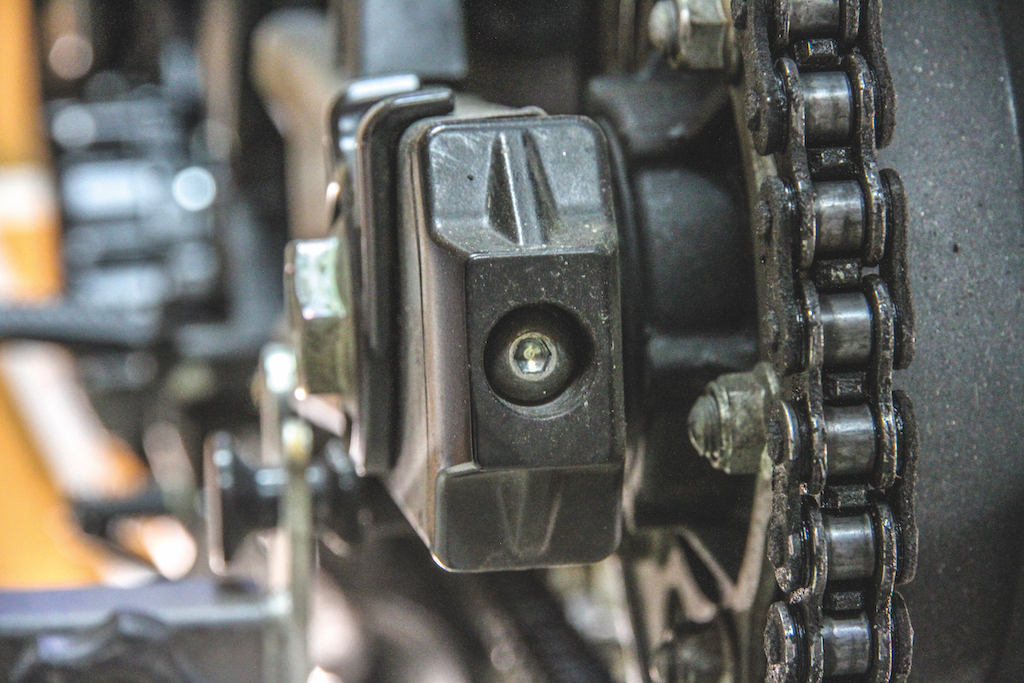
HOW TIGHT?
Keeping your chain clean and well lubricated is a basic part of motorcycle maintenance. But keeping it tensioned correctly takes a little bit more time and skill, so we thought we’d share the basics.
As you ride regularly, you’ll need to keep an eye on several things to keep your bike working at it optimum, one of which items is the chain tension. As the chain wears from normal use, it will ‘stretch’, meaning you need to adjust it every now and then to keep it at the correct tension. Given that every different bike manufacturer employs a different system for adjusting the position of the rear wheel axle (and as such, the chain tension), covering off every different style of chain adjuster would fill this whole magazine, so we’ll just focus on the basics, and why you should keep your bike’s chain adjusted to the manufacturers specs.
Chain Basics
The first thing to realise is that an incorrectly tensioned chain can be very dangerous, as well as potentially causing damage that can be very expensive to fix. New chains will ‘bed-in’ fairly quickly, meaning even if you’ve recently replaced your chain (and sprockets) or purchased a brand-new bike, you’ll need to keep an eye on the amount of free-play in the middle of the chain. The links will stretch a small amount in the first few hundred kilometres of use, which is completely normal, but it means the new chain will need adjusting fairly soon after installation on your bike. Once bedded in, the chain should easily last thousands of kilometres, assuming it is correctly cleaned and lubricated regularly, with only minimal adjustments required to keep it tensioned to the bike manufacturers specifications.
The Dangers
An incorrectly adjusted chain can cause all sorts of headaches, regardless of if it is too tight or too loose.
A chain that is too loose can be felt while riding; every time you get on the throttle, the bike will ‘jerk’ as the excess slack in the chain is pulled taut by the motor, before being transferred to the rear wheel. This is called ‘chain slap’. Generally, motorcycle owners will forget to tighten the chain as it wears and stretches, which introduces the danger of the chain slipping off the sprockets, damaging the swingarm, or even worse, your leg. Fancy doing 100km/h with a steel bandsaw wrapping itself around your calf muscle? Yeah, me neither. I’ve seen a swingarm literally broken in half from a dislodged chain, simply because the chain was too loose. Keep that in mind next time you’re giving your bike a thorough check-over.
Alternatively, if a chain is too tight, the first thing you’ll notice is that it is really hard to find neutral when you’re stopped. Or, in worse scenarios, it will be difficult to change gear when you are moving. Every time I hear riders complaining of these symptoms, I mention chain tension. If the chain is too tight, it will be pulling on the engine’s primary output driveshaft, as well as being connected to the main spline of the gearbox. Mechanically, if the output shaft bearing collapses, you’re looking at a complete engine disassembly to replace it. Not to mention the strain it puts on the gearbox.
The risks associated with a tight chain are – apart from the vast mechanical damage – just as bad as if the chain is too loose, only instead of falling off the sprockets, it’s more likely to just break and whip around anything that gets in the way as it tries to exit the bike. Remember, the chain moves a lot faster than the bike does, thanks to the final drive ratio of the sprockets, meaning it has an incredible amount of force behind it if it decides to take flight. The bigger and stronger the chain, the more momentum it carries!
The Benefits
Having a clean, lubricated, and correctly adjusted chain will make your bike feel smooth, with no jerking from chain slap, and generally just help the bike run freely. Given how easy it is to adjust your chain, once you’ve learnt how to, it really is worth it.
The difference in the ‘feel’ between two identical bikes, if one has a good chain and the other not, is astounding. It’s a good idea to keep track of how often you’re adjusting the chain as well, along with how many kays you’ve run on it, as even correctly adjusted chains don’t last forever. Do yourself a favour – get out to your shed and check yours!
… for more information from this article … see Bike Rider Magazine Issue 185

